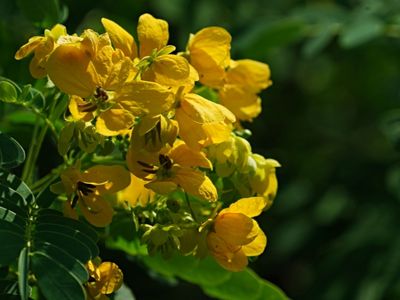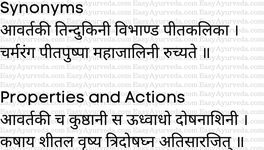Avartaki (Cassia auriculata) Uses, remedies, Properties, Morphology
Cassia auriculata is an evergreen shrub belongs to the family Caesalpinaceae. Its Flower, Seed, Bark, Fruit and leaves are widely used in Ayurvedic formulations for the treatment of Skin diseases, diabetes etc.
Table of Contents
Synonyms
Pita pushpa, Hema pusha – It has yellow coloured flowers
Vibandhi – It has sthambhaka action
Regional Names
English – Tanner’s cassia
Hindi – Taravara
Kannada – Avarike, Tangadi
Malayalam – Avara
Marathi – Tarwad
Classical categorization
It is not mentioned in Brihatrayis ( Charaka, Susruta and Vagbhata)
Taxonomy
Kingdom – Plantae
Class – Dicotyledons
Family – Caesalpinaceae
Genus – Cassia
Species – Auriculata
Habitat
Grows wild in Sothern states of India – Karnataka, Andhrapradesh

Morphology
Tall much branched shrub
Bark – Reddish brown in colour and smooth in texture
Leaf – Compound, Leaflets are 8- 12 pair in number. Dull green above and pale beneath
Inflorescence – Corymbose raceme
Flowers – bright yellow in colour
Fruit – Pod having 10- 20 seeds
Useful parts – Fruit, Flower, Bark, Leaf and Seed
Chemical constituents
Root contains – flavone glycosides, Galacto pyranoside, beta sitosterol & rutin.
Stem bark – catcehin, Epicatechin and Gallo catechin.
Plant also contains Tannin and Auriculacidine
Rasapanchaka
Rasa – Kaşaya Tikta – astringent and bitter
Guna – Laghu Rüksa – light, dry
Vipaka – Katu – pungent post metabolism taste conversion
Virya – Sheeta – Coolant
Doşa Karma (Action on Dosa) – Balances Kapha and Pitta
Karma (Action) –
Stambhaka – styptic, stops bleeding,
Krimighna – anti microbial, useful in worm infestation,
Mutrasangrähaka – retains urine,
Sukrastambhaka – useful in sexual disorders such as premature ejaculation and night fall treatment,
Kusthaghna – useful in skin diseases
Pharmacological actions – Cooling, Astringent & Anthelmintic
Therapeutic indications –
Pravahika, Atisara – diarrhea, dysentery,
Krimi – parasites, infection,
Raktasrava – bleeding due to various causes, menorrhagia, nasal bleeding, ulcerative colitis etc,
Prameha – Urinary tract infection, diabetes,
Sighraskhalana – Premature ejaculation,
Pradara – leucorrhea (white discharge),
Kushta – skin diseases with oozing, pus, discharges and secretions
Therapeutic administration
1. Atisara (Diarrhoea) – Curna (Powder) of seeds are given 6 g with water or butter milk helps in Arisara (Diarrhoea).
2. Twak vikára (Skin diseases) – Its swarasa (Fruit juice) is useful in Twak vikara (Skin diseases).
Dose
Bark decoction – 50 – 100 ml
Flower juice – 10 -20 ml
Seed powder – 3 – 6 g
Important formulations
Avartaki ghrita
Akulyadi putapaka
Adulterant
Avartaki is used as an adulterant for Markandika (Cassia angushtifolia)
Classical References
Dhanvantari Nighantu









